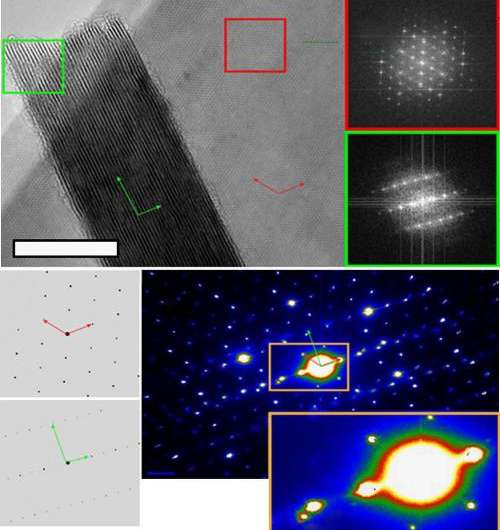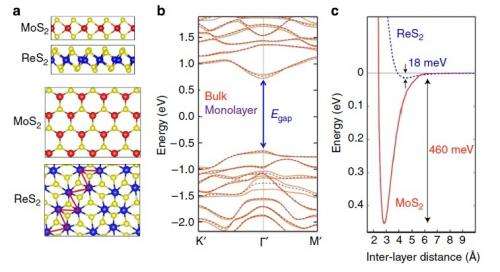February 19, 2014 feature
Scientists discover bulk material that exhibits monolayer behavior

(Phys.org) —Most materials behave very differently in bulk (3D) form than they do in monolayer (2D) form. The difference occurs because of weak forces holding the multiple layers of a bulk material together, which results in electronic and vibrational coupling that alters the material's properties. Now in a new study, researchers have discovered a new material, rhenium disulfide (ReS2), that behaves like a single monolayer of ReS2 when in bulk form. Because preparing large sheets of monolayer material is often challenging, the bulk material could provide a simple way to harness the attractive properties normally found only in monolayers. As such, the material may be ideal for flexible solar cells and super-lubricant materials.
The team of researchers, from institutions in China, the US, Belgium, and Taiwan, have published a paper on the new material in a recent issue of Nature Communications.
"Our discovery implies that bulk ReS2 would be an ideal platform to study 2D phenomena," coauthor Junqiao Wu, Professor of Materials Science at the University of California, Berkeley, told Phys.org. Wu is also affiliated with the Chinese Academy of Sciences in Beijing and Lawrence Berkeley National Laboratory in the US. "On the more applied side, the fact that bulk and multilayer ReS2 both have a direct bandgap (while other TMDs need single layers) may enable more efficient light-emitting and light-harvesting devices."
ReS2 is the newest member of a new class of materials called transition metal dichalcogenides (TMDs). As their name suggests, TMDs have the chemical formula MX2, where M is a transition metal and X is a chalcogen. Recently discovered monolayer TMDs, such as MoS2 and WSe2, exhibit attractive properties such as flexibility, stability, and a low operating voltage in various device configurations. One of the most important properties of monolayer TMDs is that they have direct bandgaps, which allows them to absorb and emit light efficiently and makes them promising candidates for next-generation flexible optoelectronics and photovoltaics materials.
However, so far these appealing properties of TMDs occur only when they are in single layers; in bulk form, coupling between the layers gives the materials an indirect bandgap, which diminishes their optical and electronic properties.

ReS2 is different than the previously discovered TMDs because, as Wu explained, it has a direct bandgap in both bulk and monolayer form. As a result, bulk ReS2 has the potential to offer properties that other TMDs have only in monolayer form. One example of this is photoluminescence. In conventional TMDs such as MoS2 and WSe2, the photoluminescence intensity is enhanced by about 3 orders of magnitude in monolayer form compared to bulk form because of the crossover from the direct to indirect bandgap. In contrast, the photoluminescence intensity of bulk ReS2 is actually slightly higher than that of monolayer ReS2 because the monolayers in the bulk form are largely decoupled, giving bulk ReS2 a direct bandgap.
By investigating bulk ReS2 using high-resolution transmission electron microscopy, electron diffraction, and density functional theory calculations, the researchers found that the new material has very weak interlayer coupling. Specifically, they calculated that the coupling energy of ReS2 is less than 8% of that of MoS2.
According to their analysis, this weak coupling can be explained by ReS2's distorted crystal structure. ReS2 can have an octahedral crystal structure, but a distorted octahedral structure is more energetically favorable. This distortion causes the Re atoms to form zigzag Re chains, which in turn prevents the layers from stacking by eliminating the energy benefit that occurs in other TMDs. As a result, there is no energy incentive for the layers to couple to each other in bulk ReS2 as there is in other TMDs.
In the future, the researchers plan to further investigate ReS2's unusual properties, while experimenting with doping, alloying, and high pressures.
"We are currently designing new materials that are likely to generate large interest in the field and also engineering ReS2's properties by creating defects in the material," said coauthor Dr. Sefaattin Tongay of the University of California, Berkeley, and the Chinese Academy of Sciences.
More information: Sefaattin Tongay, et al. "Monolayer behavior in bulk ReS2 due to electronic and vibrational decoupling." Nature Communications. DOI: 10.1038/ncomms4252
Journal information: Nature Communications
© 2014 Phys.org. All rights reserved.




















